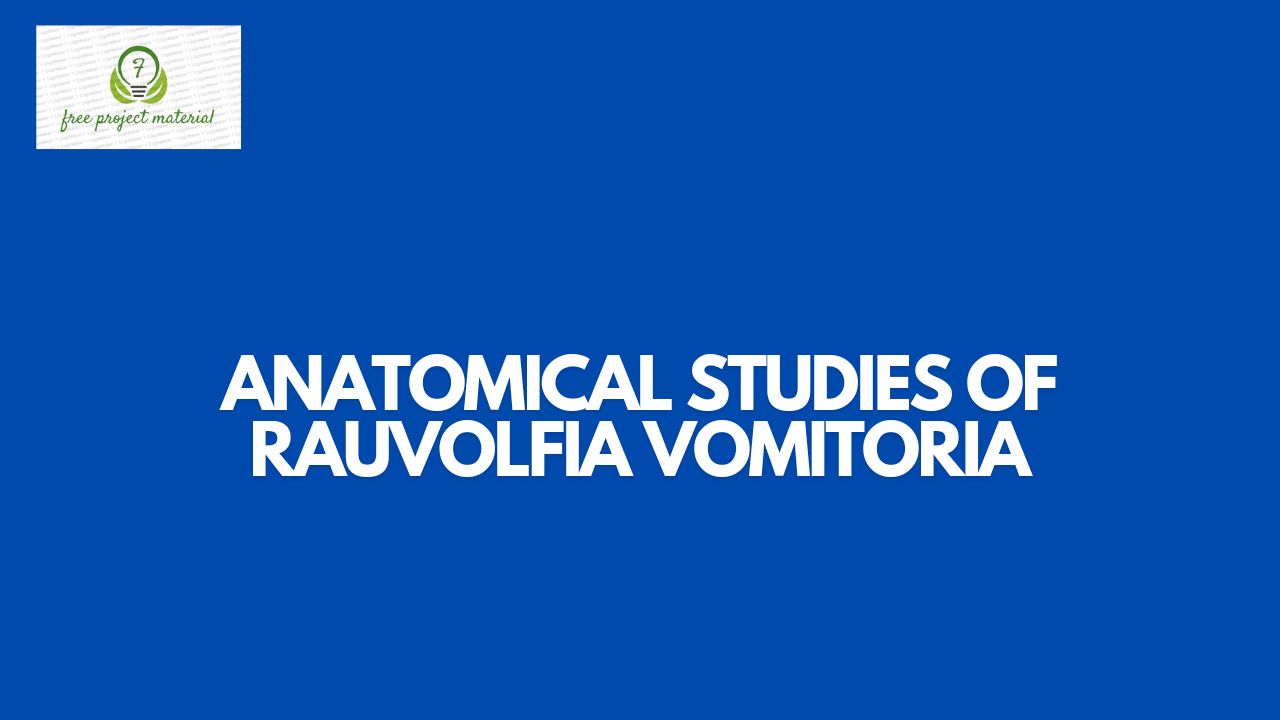ABSTRACT
Anatomical studies of Rauvolfia vomitoria was carried out using standard procedure. Upper surface (adaxial) and lower surface (abaxial), showed the following features which include: irregular and polygonal epidermal cell shapes respectively, Anomocytic stomatal type on abaxial surface and none on the adaxial surface. The trichome is absent on both surfaces. The stomatal distribution for both abaxial and adaxial surfaces was Hypostomatic stomata. The anticlinal wall pattern is sinuous-undulate in abaxial surface and straight in abaxial surface. These features could be used to delimit Rauvolfia vomitoria from others in the family.
TABLE OF CONTENTS
Title Page
Certification …………………………………………………………………….i
Dedication ……………………………………………………………………….ii
Acknowledgments ………………………………………………………………iii
Abstract ………………………………………………………………………….iv
Table of Contents …………………………………………………………….…v
CHAPTER ONE: INTRODUCTION
1.1 Background of the study …………………………………………………
1.2 Aims and Objectives ………………………………………………………
1.3 Scope and limitation ………………………………………………………
CHAPTER TWO: LITERATURE REVIEW
2.1 Botanical classification of vomitoria ………………………………
2.2 Description and ecology of vomitoria ………………………………
2.3 Distribution of vomitoria…………………………………………….
2.4 Cultivation and collection of vomitoria ………………………………
2.5 Economic importance of vomitoria ……………………………………
2.6 Chemical constituents of vomitoria ………………………………….
2.7 Pharmacological and Biological Activities ……………………………….
CHAPTER THREE: MATERIALS AND METHODS
3.1 Materials ………………………………………………………………..
3.2.1 Sample collection……………………………………………………….
3.2 Methods …………………………………………………………………..
3.2.1 Preparation of surface specimen of leaves………………………………
CHAPTER FOUR: RESULTS AND DISCUSSION
4.1 Results…………………………………………………………………..
4.2 Discussion ………………………………………………………………
CHAPTER FIVE: CONCLUSION AND RECOMMENDATIONS
5.1 Conclusion ………………………………………………………………
5.3 Recommendations ………………………………………………………
Reference
CHAPTER ONE: INTRODUCTION
1.1 Background of the Study
Apocynaceae Juss. is one of the important families in angiosperm founded in 1789. About 1900 species representing 215 genera have been identified worldwide (El-Fiki et al., 2019). According to Endress and Bruyns (2000), the family was delimited into five subfamilies, comprising of Secamonoideae, Apocynoideae, Rauvolfioideae, Periplocoideae, and Asclepiadoideae. Plants of this family are greatly diversified in lifeform to trees, shrubs, climbers and rarely herbs (Bhattacharya, 2004; Koyuncu, 2012 and Venkateshwar et al., 2013). Notable diagnostic morphological feature of the family is the production of pod-like fruits. The leaves are usually sessile or petiolate having variable shapes of lanceolate, ovate, linear, obovate, elliptic, or oblong (El-Fiki et al., 2019; Kidyoo, 2014 and Bibi et al., 2015).
Various works have been published on the epidermal characterization of many taxa of the family apocynaceae. Wriohtia tinctoria, Ervatamia divaricata, and Catharanthus roseus were delimited based on their amphistomatic leaves from six other apocynaceous species after studying the foliar epidermis of ten Indian species comprising of nine genera by Kannabiran and Ramassamy (1988). Seven species representing seven genera were investigated by El-Fiki et al. (2019) and recommended the merging of Apocynaceae and Asclepiadaceae to one big family. Nerium oleander was distinguished from other species by having stomatal crypt (Bashir et al., 2020). Despite these wonderful documentations, the taxonomic relationship among the members of apocynaceae remains unsettled and incomplete. This can be deduced from the fact that some of the African species in the family such as Astonia boonei, Holarrhena floribunda, Rauvolfia vomitoria, Thevetia neriifolia, and Vocanga africana are still being left out. These species are among the trees commonly used for traditional medicine in Nigeria. The bark of Alstonia boonei in a tincture with the bark of Enantia chlorantha is useful for the treatment of malaria and yellow fever (Odugbemi and Akinsulire, 2006). According to Fabeku (2006), the decoction of root and bark of Rauvolfia vomitoria in tandem with some species of meliaceae is efficacious in the treatment of coated tongue disease.
Often time, identification of these medicinal trees is achieved using the floral and fruiting components. However, the existence of flowers is seasonal and is therefore useless for taxonomic discrimination purpose during off-flowering and fruiting seasons.
Due to their wide application in ailment treatment, they are usually sold in the market either fragmentary or sterile conditions (Olowokudejo and Nyananyo, 1990). Hence, they are highly prone to substitution and adulteration, which is very inimical to effective application. Given the various medicinal uses of these species there is a need for thorough taxonomic revision to provide additional markers for proper discrimination of the taxa.
Natural drugs are the early source of medicine for human being and extracts from plant’s parts (seed, root, flower, stem and bark) have been used for curing various ailments in the time past. Although, the advent of modern medicine has affected the development of local herbal medicine, notwithstanding plant materials are still being used to greater extent for combatting illnesses and various diseases, and researches for novel plant extracts and isolates for the development of new medicine is the focus of many researchers (Ozusaglam and Karakoca, 2013).
Ethnobotanical medicine provides alternative sources of new drugs, an example is Rauvolfia species most found in sub-Saharan Africa and it is an important medicinal plant. They have been effective in the treatment of malaria, diabetes, and both parasitic and microbial infections (Amole et al., 1998; Campbell et al., 2006; Pesewu et al., 2008 and Zirihi et al., 2005). In particular, Rauvolfia vomitoria has been used in the treatment of coughs, gastrointestinal disturbances, skin infections, hypertension, impotence, insomnia, diarrhea, dysentery, scabies, worm infections and malaria (Odugbami, 2008; Oyedeji, 2007). The chemical components of this plant include indole alkaloids (Amer and Court, 1980 and Katič et al., 1980). R. vomitoria root contained high concentration of alkaloids; majorly reserpine and ajmaline. These alkaloid’s pharmacological abilities include antimalarial, antitumor and antidiabetes (Dewick, 2002 and Katič et al., 1980). Reserpine and ajmaline have good antioxidant activities, thus this plant is capable of reducing risks of certain type of degenerative diseases (Erasto et al., 2007 and Mazza et al., 1999).
To the best of our knowledge there is no research on the quantitative determination of the root, leave and seed of Raufolvia vomitoria, neither is there any reported comparative antimicrobial effect of their ethanolic extracts.
1.2 Aims and Objectives
1.2.1 Aim of the Study
The aim of this research project is to study the anatomical structure of Rauvolfia vomitoria
1.2.2 Objective of the Study
The objective of this research projects is to assess the anatomical features of Rauvolfia vomitoria.
1.3 Scope and Limitation
The design of this research project is to focus on the anatomical structures of Rauvolfia vomitoria.
Due to time, inadequate facilities, and financial problems, this research project is limited to Anatomical Studies of Rauvolfia vomitoria.



